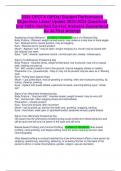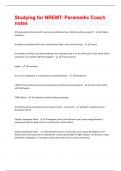Exam (elaborations)
2024 OPOTA (SPOs) Student Performance Objectives Latest Update Questions and 100% Verified Correct Answers Guaranteed A+ At First Attempt
- Course
- Institution
2024 OPOTA (SPOs) Student Performance Objectives Latest Update Questions and 100% Verified Correct Answers Guaranteed A+ At First Attempt
[Show more]




